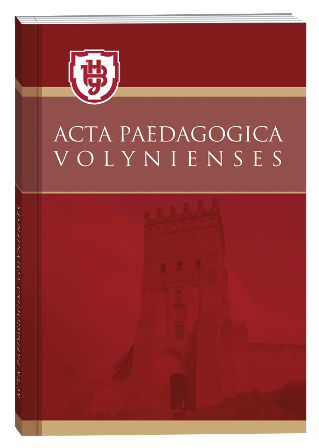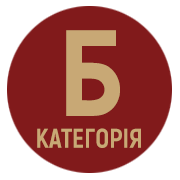ОСОБЛИВОСТІ АДАПТАЦІЙНИХ МОЖЛИВОСТЕЙ СЕРЦЕВО-СУДИННОЇ СИСТЕМИ У ДІТЕЙ МОЛОДШОГО ШКІЛЬНОГО ВІКУ
DOI:
https://doi.org/10.32782/apv/2023.2.11Ключові слова:
адаптаційний потенціал, серцево-судинна система, діти шкільного віку, медичні групи з фізичного вихованняАнотація
У статті розглянуто актуальне питання адаптаційних можливостей серцево-судинної системи у дітей молодшого шкільного віку, які були поділені на основну, підготовчу та спеціальну медичні групи з фізичного виховання. У дослідженнях взяли участь школярі початкових класів, віком від 6 до 10 років. За даними із медичних карток іх було поділено на основну, підготовчу та спеціальну медичні групи з фізичного виховання. Тривалість досліджень склали 9 місяців. Під час обстеження учнів, ми використовували такі матеріали та прилади, як: тонометр з фонендоскопом, медичні ваги, ростомір, секундомір. Провівши всі обстеження, ми обраховували адаптаційні можливості організму, використовуючи формулу адаптаційного потенціалу (АП). АП розраховується за формулою (за Р. М. Баєвським та модифікацією формули авторським методом Н. В. Богдановською). Аналіз про можливості рівня адаптаційних можливостей учнів визначали за шкалою рівня адаптаційних можливостей за Н. В. Богдановською. Статистичну обробку даних здійснювали застосовуючи статистичний пакет MedStat. Нами висвітлено результати особливостей адаптаційних можливостей серцево-судинної системи враховуючи індивідуальний підхід до кожного учня. Ми прийшли до висновку, що варто звертати увагу на функціональний стан організму, зокрема на адаптаційні можливості серцево-судинної системи та враховувати під час фізичного навантаження дітей різних медичних груп. Фізичні вправи можуть бути використані як для групового виконання, так і індивідуально окремими учнями відповідно до їх бажання та емоційно-фізичного стану. Індивідуалізації вправ дозволить підтримувати стан учнів, а також розподіляти навантаження між груповими та індивідуальними активностями, досягати ефективно використання часу на уроці для всіх учнів. Отримані результати можуть слугувати теоретичним підґрунтям для розробки методичних рекомендацій, в яких передбачено способи проектування технологій для формування здоров’я молодших школярів під час освітнього процесу через уроки фізичної культури з врахуванням поділу учнів на медичні групи здоров’я.
Посилання
Арабаджи, Л. І. (2012). Адаптаційний потенціал системи кровообігу студентів. Ukrainian Journal of Ecology, (1), 6−12.
Бигар, Г. П., Чуньківська, І. С. (2021) Особливості організації здоров’язбережувального середовища в сучасній початковій школі. Актуальні проблеми педагогіки початкової школи в контексті освітньої реформи: зб. наукових праць. укл. Поясик О. І., Слипанюк О. В., Ковальчук М. П. Івано-Франківськ: НАІР, 13−16.
Богдановська, Н. В., & Бойченко, Ю. Б. (2014). Динаміка адаптивних можливостей організму дітей шкільного віку протягом навчального року. Вісник Запорізького національного університету. Фізичне виховання та спорт, (1), 112−120.
Волошин, О. С., Гуменюк, Г. Б., Волошин, В. Д., & Сморщок, Ю. С. (2022). Оцінка адаптаційних можливостей осіб юнацького віку з різним рівнем ефективності функціонування серця. Здобутки клінічної і експериментальної медицини, 4, 83−88.
Головченко, О. І. (2021). Стан функціонально-резервних можливостей серцево-судинної системи студенток з різним рівнем рухової активності. Педагогіка, психологія та медико-біологічні проблеми фізичного виховання і спорту, 8. 25–29.
Гончарова, Н. (2017). Основні положення концепції здоров’яформуючих технологій в процесі фізичного виховання дітей молодшого шкільного віку. Journal of Education, Health and Sport formerly Journal of Health Sciences. Kazimierz Wielki University in Bydgoszcz. [Інтернет]. Bydgoszcz, Poland, 7(1). 634–648.
Коваль, Л. В. (2011). Організація здоров’язбережувального навчально-виховного процесу в початковій школі з урахуванням психофізіологічних особливостей молодших школярів. Наука і освіта: наук.-практ. Журнал, 2. 23–25.
Кондратюк, С. М. (2010). Сучасні проблеми формування здорового способу життя молодших школярів. Педагогічні науки: теорія, історія, інноваційні технології. Суми: СумДПУ імені А. С. Макаренка, 180–188.
Коц, С. М., Коц, В. П., & Луганська, В. О. (2021). Адаптаційний потенціал сучасних дітей віком 10–11 років. Освіта і здоров’я підростаючого покоління: Матеріали третього міжнародного симпозіуму: Зб. наук. праць в 2-х частинах / За ред. Страшка С. В. 3.(1). К.: Алатон, 94.
Кравченко, Т. П. (2020). Особливості формування в дітей молодшого шкільного віку ціннісного ставлення до власного здоров’я в процесі фізкультурно-оздоровчої роботи. Науковий часопис НПУ імені М. П. Драгоманова, 7 К (127), 51–54.
Лисенко, Л. Л., Вітченко, А. М., Корнєва, А. М., & Мельникова-Єгорченко, Н. С. (2018). Формування культури рухів дітей молодшого шкільного віку як складова їх здоров’язбережувальної компетентності. Актуальні проблеми фізичної культури, спорту, фізичної терапії та ерготерапії: біомеханічні, психофізіологічні та метрологічні аспекти : Матеріали І Всеукраїнської електронної науково-практичної конференції з міжнародною участю (Київ, 17 травня 2018 р.) / ред. Г. В. Коробейніков, В. О. Кашуба, В. В. Гамалій. Київ: НУФВСУ, 2018. 144–146.
Лях, Ю. Є., Гур’янов, В. Г., Грицай, О. С. (2017). Комп’ютерна технiка та методи математичної статистики. Науково-доказова практична дiяльнiсть у фiзичнiй терапiї: метод рек. для самостiйної пiдготовки до практ. занять. Луцьк: Вежа-Друк, 97 с.
Чуньківська, І. С. (2021). Особливості створення здоров’язбережувального середовища в початковій школі. Кваліфікаційна робота на здобуття ступеня вищої освіти «магістр» спеціальності 013 Почакова освіта. Чернівці, 89 с.
Balashov, D., Bermudes, D., Rybalko, P., Shukatka, O., Kozeruk, Y., & Kolyshkina, A. (2019). Future Physical Education Teachers’ Preparation to Use the Innovative Types of Motor Activity: Ukrainian Experience. TEM Journal, 8(4), 1508–1516.
Bezkopylnyi, O., Bazylchuk, O., Sushchenko, L., Bazylchuk, V., Dutchak, Y., & Ostapenko, H. (2020). Peculiarities of application of interactive educational technologies in training of future teachers of physical culture to work with health protection in secondary school. Journal of Physical Education and Sport, 20, 291–297.
Demchenko, I., Maksymchuk, B., Bilan, V., Maksymchuk, I., & Kalynovska, I. (2021). Training future physical education teachers for professional activities under the conditions of inclusive education. BRAIN. Broad Research in Artificial Intelligence and Neuroscience, 12(3), 191–213.
Juraevich, M. J. (2020). Actual problems of teaching physical culture in schools. Asian Journal of Multidimensional Research (AJMR), 9 (11), 181–187.
Misjura, A., Vrublevskiy, E., & Albarkaayi, D. (2019). Physical culture in the life of elementary school pupils. Спортивний вісник Придніпров’я, 3, 2019.
Redchuk, R., Doroshenko, T., Havryliuk, N., Medynskii, S., Soichuk, R., Petrenkо, O., ... & Boretskyi, V. (2020). Developing the Competency of Future Physical Education Specialists in Professional Interaction in the Field of Social Communications. Revista Romaneasca Pentru Educatie Multidimensionala, 4(12), 289–309.
Romanchenko, I., Prokopenko, A., Zaichko, I., Prokopenko, L., Rybalko, P., Bobrovytska, S., & Kyselyova, O. (2021). Methods of Introducing Information Technologies into the Educational Process of Higher Education Institutions of Ukraine. International Journal of Computer Science and Network Security, 21(5), 16–22.
Zadorozhnia, V. Kuchkovsky, O. Kovaleva, O. (2020). Vegetative status and adaptation peculiarities possibilities in student youth depending on blood circulation self-regulation type. Вісник Львівського університету. Серія біологічна. 83, 83–97.







